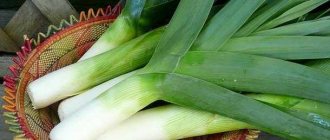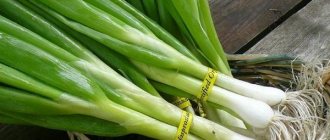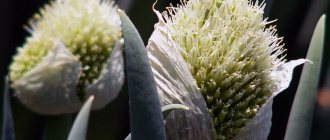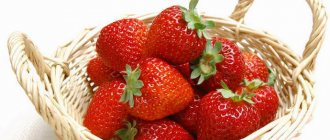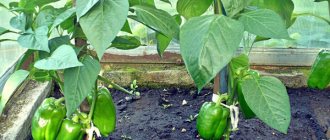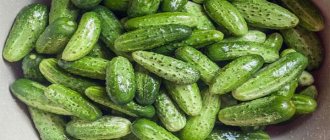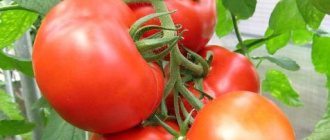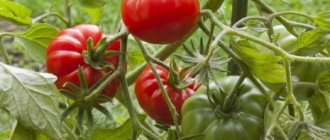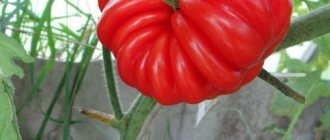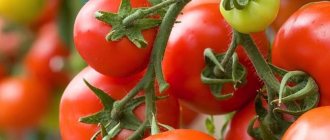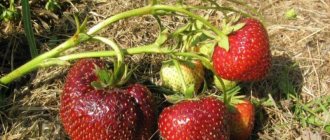Multi-tiered onion, botanical information
Multi-tiered onions also have other names. In other sources you can often find such names as Egyptian, Canadian, walking.
Description of the bulb, appearance, taste
Externally, this culture is very similar to batun. Long leaves are formed on the head, reaching a diameter of approximately 1.5 cm, with a bluish coating throughout the entire blade. A distinctive feature is that instead of seeds, small bulbs are formed during flowering, from which new feathers later grow. Up to 5 such tiers are formed per season. The lower ones have a mass of up to 25 g, and the upper ones reach up to 5 g.
Note! Before the appearance of a new tier, the feathers taste very similar to regular ones; after the formation of new bulbs, they become tougher, but also suitable for eating.
Multi-tiered onions are a rare guest in Russian beds
A little history
It is believed that the birthplace of the multi-tiered bow is Ancient China. At that time, a culture was known with the name Lau-chi-tsun, meaning “grass that grows in layers and does not form seeds.” This onion is popular among the Chinese; it is used to make various dishes.
By the mid-17th century, the culture had spread throughout East Asia, from where it was brought to England and to European countries. The plant came to Russia at the end of the last century. Initially, it was grown only in botanical gardens, but gradually “migrated” to the garden beds of summer residents.
Advantages of cultivation and benefits
The root system of the crop is quite long and extends about 1 m into the ground. The plant is unpretentious, well resistant to frost and dry weather.
The composition contains many useful substances: vitamins, microelements, phytoncides, amino acids. The feather has an antibacterial and antimicrobial effect, even if consumed after freezing. When used, it has an antioxidant effect.
The culture attracts with its unusual appearance and valuable properties
Beneficial features
This onion variety, like all other varieties, has beneficial properties. Used in traditional and folk medicine. It is used both for the treatment and prevention of diseases. Based on medical research, it can be understood that multi-layered onions contain a large amount of phytoncides, which in turn are successfully used as a means to relieve inflammation. Multi-level onions are also widely used in the treatment and prevention of hypertension.
It is also used for the prevention and treatment of the stomach and intestines.
In folk medicine, onions are used in the form of juices, compresses and as aromatherapy. When treating and preventing diseases of the upper respiratory tract, you need to cut the onion into several parts and breathe in the onion aroma several times a day. To relieve pain in the ears, you need to dilute the onion variety with water and drip into the ears. Also, with the help of an onion, you can heal a wound that does not heal for a long time. If a wasp bites you, you should immediately smear the bite site in half with a cut onion. This will relieve pain.
Using compresses made from onion pulp, you can also relieve pain from bruises and joint pain.
At the moment, the multi-tiered bow is little known. It is known only in certain regions of Russia. The bulbs of this variety contain a large number of biologically active substances beneficial to the body. And in this area it is not inferior to even the most popular onion varieties.
Varietal diversity
There are several popular types of culture. Each of them has its own characteristics. The most common include:
- Chelyabinsk. It is characterized by high productivity and unpretentiousness. The bulbs are dense and crispy, with a distinct taste. Full ripening occurs in 20 days.
- Odessa winter 12. Up to 30 bulbs can ripen at the same time on the arrow. The feathers reach a length of up to 40 cm and have a pungent taste.
- Memory. Belongs to early varieties, grows very quickly, from 1 sq. m you can collect up to 3.5 kg of feathers. An average of 4 sheets are formed on the head.
- Gribovsky 38. Frost-resistant species that can be grown in the Urals and Siberia. Harvesting the first harvest is possible already 3 weeks after the snow melts. The plant is compact and dense.
- Likova. Grows well even in insufficient light. At the same time, it has a good yield - up to 3.6 kg.
Note! The double-tiered onion became known relatively recently, so not too many varieties of it have been developed yet.
Description of the plant
The plant received its name due to the peculiarities of the development of the above-ground part.
Green leaves stretch from the ground, and instead of inflorescences, aerial bulbs-bulbs are formed, from the junction of which new flower stalks with bulbs emerge. Thus, the onion grows in several tiers.
China is recognized as the birthplace of this plant. It was there that seedlings of a similar species were first discovered. Then the onion came to Europe and only in the 17-18 centuries. reached Russia.
The leaves have a hollow structure, they are thick, up to 2 cm in girth, rich green and juicy. The height of each shoot is usually 40–50 cm, but some stretch up to 1 m. The inflorescences are represented by a collection of aerial bulblets, the total number of which ranges from 3 to 30 at one point of convergence. The diameter of each depends on the tier; the lower they are located, the larger they are. The first level contains bulbs, the size of which is up to 3 cm, weight up to 25 g. The upper tiers include fruits weighing no more than 4 g.
Horned onions are distinguished from classic varieties of onions by a sharper and richer taste and excellent frost resistance. The bulbs tolerate winter cold up to 50 degrees.
Unlike other species of the family, multi-tiered onions begin to grow when the air warms up to 10 degrees. The bulbs do not have a dormant period and continue to develop on the peduncle constantly. The underground organ grows to full strength by September.
The use of multi-tiered bows
This plant primarily has a food purpose. Both shoots and bulbs (underground and aerial) are edible, regardless of whether it is a wild variety or grown in your own garden. The leaves and bulbs have a richer and sharper taste compared to other varieties of onions. They are more nutritious and contain more vitamins. The leaves are consumed fresh in spring and early summer, the bulbs are salted and pickled.
Thanks to the phytoncides contained in the composition, parts of this plant allow their use as a traditional medicine. The components increase immunity, protect against colds, help fight gum disease, vitamin deficiency, hypertension and gastrointestinal problems.
The use of allium in ornamental gardening is also popular. Thanks to its interesting bulbous inflorescences, multi-tiered structure, and early flowering, it has a practical role in garden landscaping. The following application options are possible in landscape design:
- For the parterre garden. It will be a suitable element due to the early appearance of greenery.
- As a decorative frame for paths. Allium is planted a short distance from the edge of the path and from the next plant. After a few weeks, interesting and unconventional framing of the paths is observed.
- As an integral element of a rock garden, a rocky hill. The height of the plant allows it to be used as one of the central elements, surrounded by shorter neighbors. The design of such an ornamental garden with stones (gravel, crumbs, boulders) looks beautiful.
- As a component of allaria. This type of garden composition involves the use of only onions of various types. Select 1-2 high center elements, surrounding them with low ones. Also the flowering period and characteristic color. Allary will delight the gardener all year round. The following varieties become neighbors of multi-tiered onions: chives, anzur, bear, blue, oblique, Pskem, Ostrovsky.
The peak of the plant's decorative potential comes in the summer, and by July-August the bulbs are removed.
Varieties
There are several popular varieties of viviparous onions. The most common types:
- Memory. An early variety characterized by rapid germination and excellent growth of green mass. The period before cutting the leaves is about 24 days. In one procedure, 1.5 kg of greenery is removed from 1 square. m, and per season up to 3 kg, of which up to 0.7 kg is obtained from aerial bulbs. The bulbs are purple in color, elongated, usually grow in 3 tiers.
- Likova. Harvesting begins 20 days after planting, even if the amount of sunlight was low. The shoots have a waxy coating, the bulbs are greenish-violet in color, oval, weighing about 6 g, connected in inflorescences of 3–8 pieces. Productivity – 3.6 kg per 1 sq. m.
- Odessa winter. The shoots are light green, about 30–40 cm in height. The bulbs are oval, reddish-violet, with up to 30 aerial bulbs on one plant.
- Chelyabinsk. The ripening time of the first harvest is 20 days. The variety is resistant to cold.
- Gribovsky 38. The shoots of the first tier stretch 40 cm, another 2 layers are slightly less. The ripening period is 21 days.
All varieties are highly branched and tolerate cold well.
Landing rules
It is necessary to create beds 1 m wide. Leave an interval of approximately 30 cm between them. If the seeds are large, then they need to be planted at a distance of up to 6 cm, if small, 4 cm is enough. The depth of the furrow is up to 3 cm. Planting can be done in a checkerboard pattern.
After sprouts form, the vegetable is thinned out. If growing three-tiered or more onions is planned for several years, then at least 20 cm should remain between the bushes. In winter, it is better to cover the growing area with a large amount of snow so that the bulbs do not freeze.
Cultivation care
Longline onion is an unpretentious plant. Caring for it is quite simple. After the onset of warm weather, it is recommended to inspect the beds with seedlings.
The soil on the site should remain slightly moist. Water when the top layer of soil dries. It is enough to supply water once every 2 weeks. During the dry period, irrigation is carried out once every 7 days.
Multi-tiered crops like feeding. After the snow melts, it is watered with a solution of mullein and ash (1 liter of manure and 1.5 tbsp of ash are diluted in 10 liters of water). It is allowed to use complex fertilizers at the rate of 60 g of product per 1 bucket (10 liters of the resulting liquid is enough to enrich 1.5 sq. m).
In autumn, it is recommended to pour humus onto the planting site so that the bulbs can survive frosts.
It is important to regularly loosen and weed to ensure air access to the roots and kill weeds.
Sometimes onions grow very large
Many summer residents tie up multi-tiered bows. This is an optional procedure, but it helps improve the quality of new bulbs.
Basic principles of reproduction
Multi-tiered onions are propagated vegetatively and only because this plant does not throw out seeds. Digging underground bulbs can be done during the growing season of the plant and after. They can be eaten, but this type of onion is valued precisely for the taste characteristics of the aerial bulbs.
The overgrown mother bulb is divided into parts and transferred to a new place; aerial bulbs can also be used for propagation, which, when planted, quickly take root and produce new greenery.
Multi-tiered onions are propagated and planted as both annual and perennial crops.
Without replanting in one place, multi-tiered onions can grow for up to 5 years, then the plant should be replanted.
The aerial fruits of multi-tiered onions for sowing should be collected as soon as the root tubercles are formed on the onion bottom. Collected bulbs tend to germinate quickly, so do not store them outside the ground for longer than two weeks, but rather plant them immediately. It is better to collect aerial bulbs for planting in August, and eat the fruits obtained earlier.
To get strong planting material, select a couple of onion bushes, and do not cut the greens from them more than twice during the growth period.
Cleaning and storage
The first harvesting is best done in mid-June. Feathers are eaten raw or frozen. If desired, you can remove the arrow, then the onion will produce 2 harvests per season, but will remain single-tiered.
Aerial bulbs are allowed to be harvested in the second part of the summer season. They can be distinguished by their characteristic color. Bulbs are often used for pickling.
Ripe bulblets
Growing onions at home
If desired, this onion can be grown at home on a windowsill. To do this, small heads are planted in a container with suitable soil. The pot should be placed in a bright place and monitor the soil moisture. After some time, young feathers will appear. They will not be long, but even in this form they taste good, are elastic and full of vitamins.
Multi-tiered Egyptian onion is an interesting plant that even a novice gardener can get in his garden. It is important to follow all the rules of agricultural technology, then you will be able to cut high-quality and healthy greens throughout the season, and then acquire high-quality root crops.
